Want to build a fuller, more balanced chest?
This guide covers the best upper chest workouts and exercises based on science—plus training tips to maximize growth.
After years of lifting, my chest looked big—but soft, round, and bottom-heavy.
My lower chest dwarfed my upper chest, and the imbalance made everything else—my shoulders, arms, even my posture—look off.
I followed the most common advice you read online: more benching, more sets, more upper chest isolation work.
None of it made a difference.
Then I learned what actually builds the upper chest—what exercises work it best, how hard you really need to train, and why progressive overload is paramount.
Within a couple of years, here’s how my upper chest transformed:
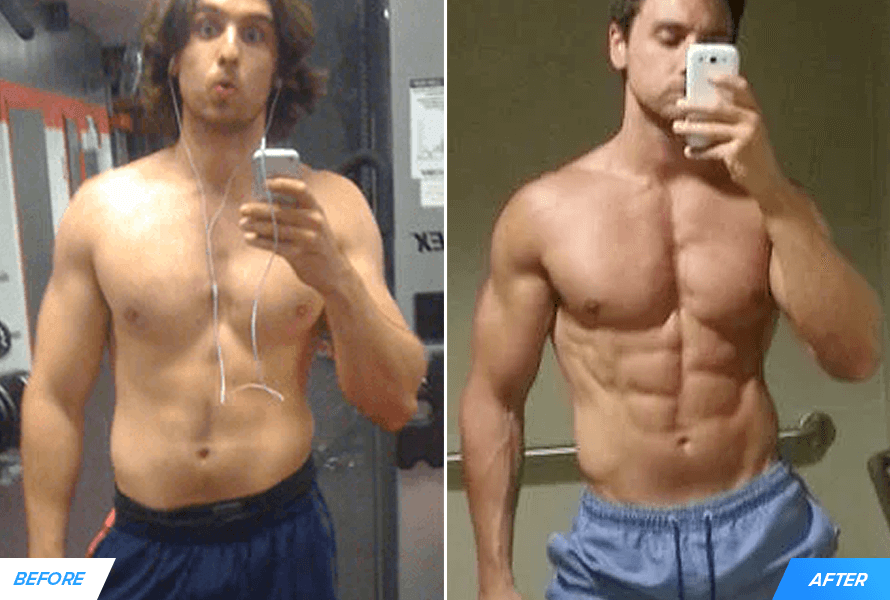
In this article, I’ll break down the upper chest exercises, workouts, and training methods that helped me build the full, armor-plated look most guys are after, so you can do the same.
Let’s dive in.
Want to know exactly how you should train to reach your fitness goals? Take our free 60-second training quiz and find out now.
Key Takeaways
- The upper chest refers to the upper portion of the pectoralis major, technically called the clavicular head.
- Its main functions are bringing your upper arms toward your midline and lifting them from out in front of you overhead. To work the upper chest effectively, do exercises that involve these movements.
- To build the upper chest, prioritize upper chest exercises, train your pecs with 10-to-20 weekly sets, get stronger over time, and train close to failure.
- To accelerate your progress, use a high-quality protein powder to hit your daily protein target, creatine to boost recovery and growth, and a pre-workout to enhance energy, focus, and performance.
- The best upper chest exercises are barbell and dumbbell incline, flat, and close-grip presses.
What Is the Upper Chest?
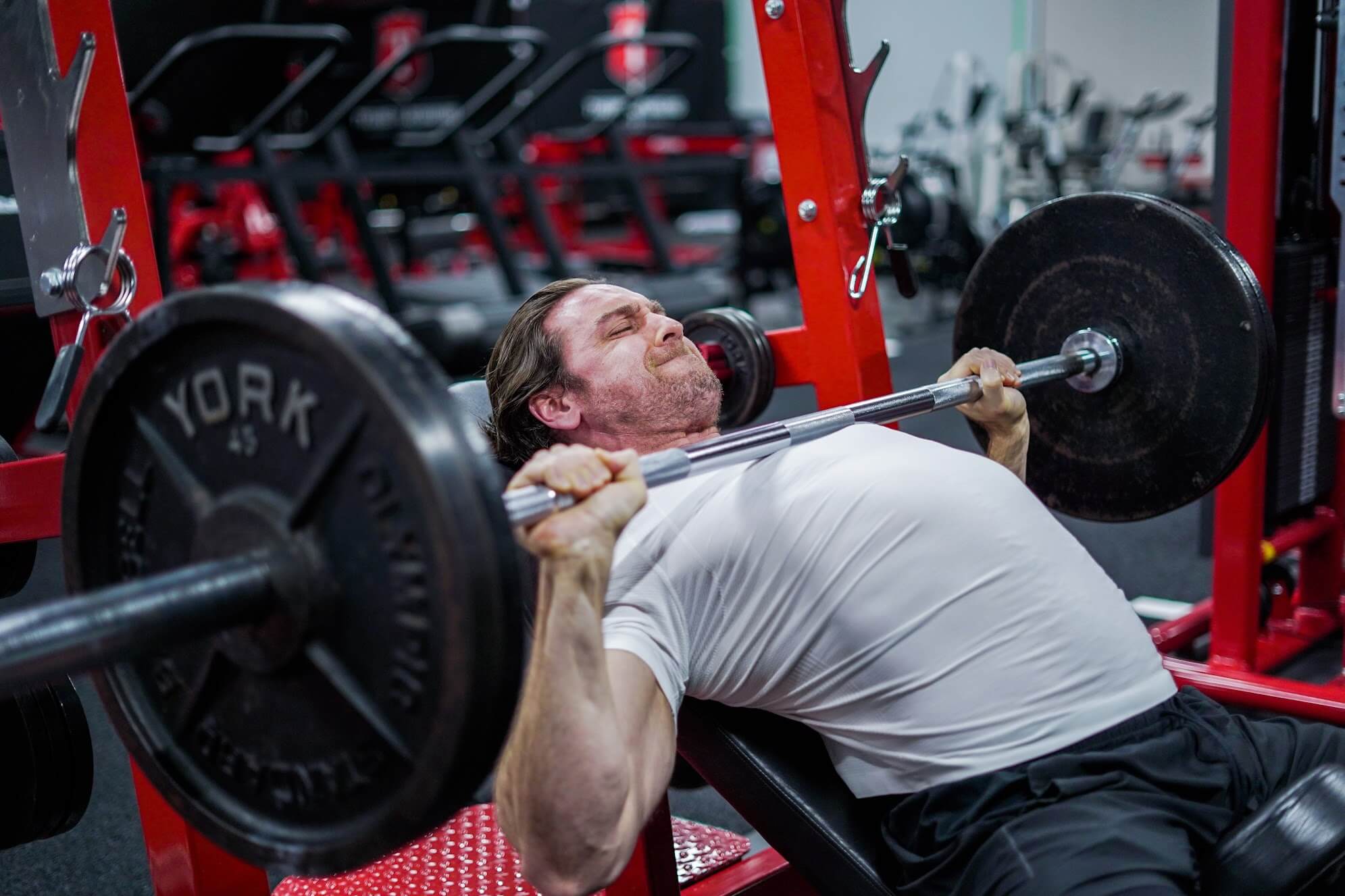
When people talk about the upper chest, they mean the clavicular head of the pectoralis major—the part of your chest muscle just beneath your collarbone.
It’s one of two main sections of the “pec major,” the other being the sternocostal head:
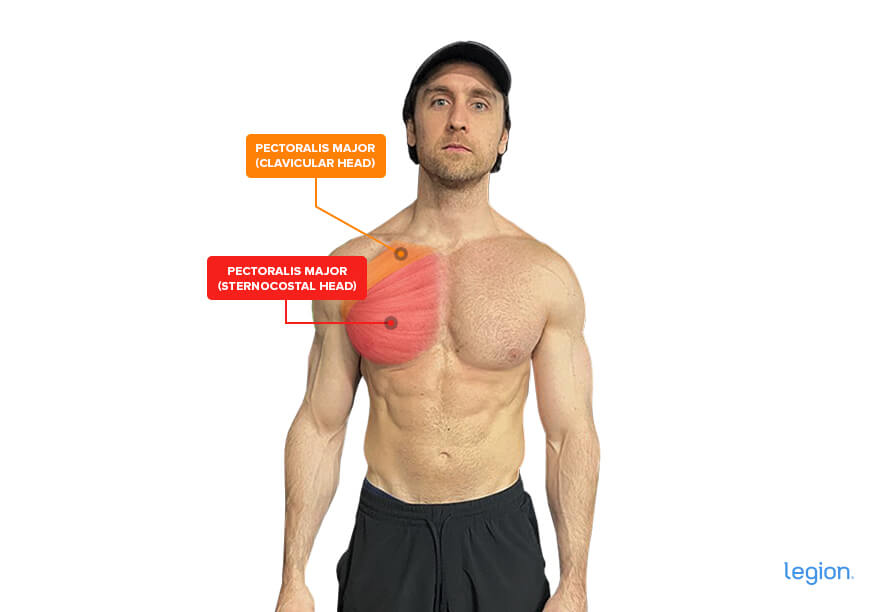
How Do You Work the Upper Chest?
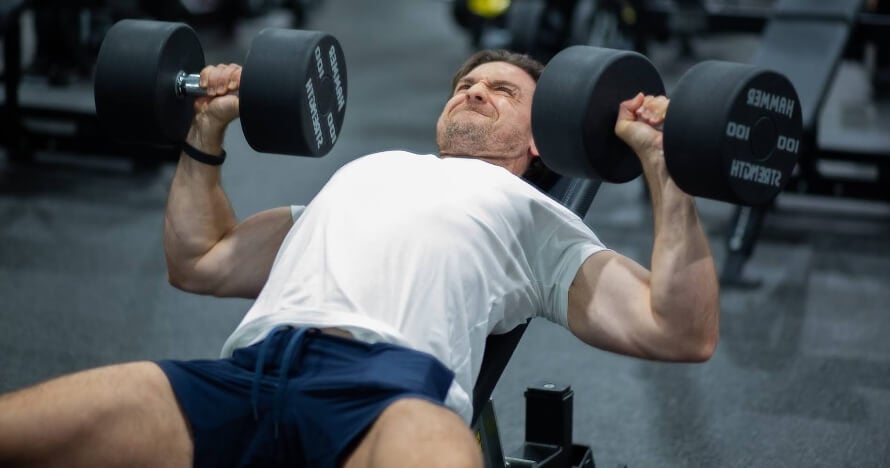
To effectively work the upper chest, you have to perform exercises that match the direction its muscle fibers pull.
These fibers run from your collarbone to your upper arm, which means you work the upper pecs most when you push away from your torso and slightly upward.
Technically, they’re most involved in:
- Horizontal shoulder adduction: Bringing your upper arms from out at your sides toward your midline
- Shoulder flexion: Lifting your arms from out in front of you overhead
That’s why the best exercises for working the upper chest tend to be presses performed on an incline, such as the incline barbell or dumbbell bench press.
Can You Isolate the Upper Chest?
Not entirely. You can emphasize the upper chest by choosing exercises that involve bringing your upper arms toward your midline and slightly upward, but you can’t isolate it completely.
That’s because all pressing and fly movements involve the entire chest to some degree. In other words, even when you target the upper pecs, the mid and lower fibers still contribute.
The goal, then, isn’t to isolate the upper pecs—it’s to emphasize them using exercises that train them at the right angles and through the correct ranges of motion.
What’s the Best Incline Angle for Working Your Upper Chest?
For most people, setting the bench to a 30-to-45-degree angle works best for training the upper chest.
This range comes from three studies: one found 30 degrees was optimal, another favored around 45 degrees, and a third found no meaningful difference between the two.
So while there’s no universal “best” angle, odds are that somewhere in the 30-to-45-degree range will work well for you.
A smart approach is to start at 30 degrees and adjust based on how the movement feels:
- Lower the angle if you feel your shoulders taking over.
- Try arching your back less or increasing the incline to around 45 degrees if you feel your mid or lower chest working more than your upper pecs.
- Avoid angles above 45 degrees unless you have a very exaggerated back arch, as this tends to shift the focus away from your pecs and onto your delts.
How Do You Build the Upper Chest?

Understanding how to train your upper pecs is a good start, but to actually build your upper chest, you need to train it with the right strategy. Here’s what that looks like:
Prioritize Upper Pec Exercises
To build your upper chest, you need to make upper chest exercises the priority in your workouts.
That means placing them first in your chest, push, or upper body sessions—when your energy and performance are highest.
For example, if you normally start with the flat barbell bench press (an excellent all-around chest builder), consider replacing it with the incline bench press, which places more emphasis on the upper pecs.
Optimize Your Volume
Research shows that most people build muscle best when they do 10-to-20 sets per muscle group per week. Doing more than 20 might produce better results for some, but growth rapidly diminishes beyond this point, so the extra work is rarely worth the effort.
That’s why 10-to-20 weekly sets is a solid volume target for your upper pec workouts. It’s not a good idea to do this all in one workout, though. Studies show that a muscle can only tolerate around 6-to-10 sets in a single workout before its performance dips.
When that happens, you lift less weight, for fewer reps, with worse form—all of which hinders your gains.
A better approach is to split your volume across two upper chest workouts weekly. Here’s how to break it down based on your experience:
- <1 year of training experience: 10-to-12 sets of upper chest exercises per week split across 1-to-2 workouts
- 1-to-3 years of training experience: 12-to-15 sets of upper chest exercises per week 2-to-3 workouts
- 3+ years of training experience: 15-to-20 sets of upper chest exercises per week 2-to-3 workouts
Focus on Progressive Overload
To continue building muscle, you need to gradually lift heavier weights over time. This is called progressive overload and it’s the primary driver of muscle growth.
Here’s how to do it:
If your workout calls for 4-to-6 reps of the incline barbell bench press and you complete 6 reps in a set, increase the weight by 10 pounds for your next set.
If you do 3 reps or fewer in subsequent sets, reduce the load by 5 pounds to stay in the 4-to-6 rep range.
Apply this approach to every exercise in your upper chest workouts, aiming to add either weight or reps every session.
READ MORE: Double Progression Guide: How to Use Double Progression to Gain Muscle and Strength
Train Close to Failure
To make your upper chest workouts as effective as possible, take most of your sets to within 1-to-2 reps of failure—the point where you can’t perform another rep with proper form.
To gauge whether you’re reaching this point, ask yourself at the end of each set: “If I had to, how many more reps could I have done with good form?”
If the answer is more than two, increase the weight or reps on your next set to make it more challenging.
READ MORE: Does Training to Failure Help You Build More Muscle? What Science Says
Take the Right Supplements
These supplements will help you optimize your performance and gains while following your upper chest workouts:
- Protein powder: Protein powder, such as Whey+ (Legion’s whey isolate) or Casein+ (Legion’s micellar casein), provides your body with the nutrients needed to build muscle tissue and recover from workouts.
- Creatine: Creatine boosts muscle and strength gain, improves anaerobic endurance, and reduces muscle damage and soreness from your workouts. For a natural source of creatine, try Legion’s creatine monohydrate, creatine gummies, or post-workout Recharge.
- Pre-workout: A high-quality pre-workout enhances energy, mood, and focus, increases strength and endurance, and reduces fatigue. For a top-tier pre-workout containing clinically effective doses of 6 science-backed ingredients, try Legion’s Pulse with caffeine or without.
(If you’d like even more specific advice about which supplements you should take to reach your health and fitness goals, take the Legion Supplement Finder Quiz, and in less than a minute, you’ll know exactly what supplements are right for you.)
The Best Upper Chest Exercises

In this section, you’ll find the best upper chest exercises for building size and strength.
These movements work well because they train horizontal shoulder adduction and shoulder flexion, allow you to lift heavy weights safely, and make it straightforward to apply progressive overload—everything you need to add mass to your upper pecs.
Whether you want to build a complete upper chest workout or just add a few new upper pec exercises to your routine, these are the ones to focus on.
1. Incline Barbell Bench Press
Why: The incline barbell bench press is widely considered the gold standard of upper chest exercise because it trains both functions of the upper pecs. That’s likely why multiple studies show it works the upper chest more than flat pressing.
Using a barbell also adds stability, so you can lift heavier weights and better overload the upper chest. That’s why nearly every great upper chest workout starts here.
How to:
- Lie on a bench angled at 30-to-45 degrees and plant your feet on the floor.
- Pull your shoulder blades together and down, and without lifting your butt or shoulders off the bench, slightly arch your back.
- Grab the bar with a slightly wider than shoulder-width grip and unrack the barbell.
- Lower the barbell to your upper chest, keeping your elbows tucked 6-to-8 inches from your sides.
- Press the bar back to the starting position.
Expert Tip: Avoid lowering the bar to your mid-chest like you’re flat bench pressing. Instead, bring it to around clavicle height to maintain the proper bar path and emphasize the upper pecs.
READ MORE: Incline Bench Press: A Definitive Guide to Incline Form & Set Up
2. Incline Dumbbell Bench Press
Why: The incline dumbbell bench press trains your upper pecs similarly to the barbell version, but with one advantage: you can move through a slightly larger range of motion (ROM) since there’s no bar restricting your movement. That matters because training through a full ROM generally benefits muscle growth.
How to:
- While lying on a bench angled at 30-to-45 degrees, hold a dumbbell in each hand and rest them on your thighs.
- Lie back, hoisting the dumbbells up so you’re holding them on either side of your chest by giving them a nudge with your thighs.
- Press the dumbbells over your upper chest until your arms are straight and your elbows are locked.
- Lower the dumbbells to the starting position.
Expert Tip: Bring the dumbbells together as you press them upward to feel a stronger contraction in your pecs.
READ MORE: How to Do an Incline Dumbbell Press & Common Alternatives
3. Flat Barbell Bench Press
Why: Incline pressing gets most of the attention for upper chest development—but research shows the flat bench press is also highly effective for building your upper pecs. While it shouldn’t be your only upper chest exercise, keeping it in your routine helps round out your chest development and lets you lift heavier loads overall.
How to:
- Lie on a flat bench and place your feet flat on the floor.
- Pull your shoulder blades together and down, and without lifting your butt or shoulders off the bench, slightly arch your back.
- Grab the bar with a slightly wider than shoulder-width grip and unrack the barbell.
- Lower the barbell to your chest, keeping your elbows tucked 6-to-8 inches from your sides.
- Press the bar back to the starting position.
Expert Tip: As you set up for the bench press, imagine screwing your feet into the floor by turning your toes out to the side. This creates tension in your legs, which increases the stability and rigidity of your entire body and ensures you don’t waste energy trying to maintain balance.
READ MORE: The Definitive Guide to Proper Bench Press Form
4. Flat Dumbbell Bench Press
Why: The flat dumbbell bench press is a great complement to barbell pressing because each arm has to work independently. This helps you find and fix muscle and strength imbalances, helping you build more balanced size and strength.
How to:
- While sitting on a flat bench, hold a dumbbell in each hand and rest them on your thighs.
- Lie back and bring the dumbbells up so you’re holding them on either side of your chest by giving them a nudge with your thighs.
- Press the dumbbells over your chest until your arms are straight and your elbows are locked.
- Lower the dumbbells to the starting position.
Expert Tip: Exercises that train each side of your body independently (“unilateral exercises”) are typically better for improving athletic performance than exercises that train both sides simultaneously (“bilateral exercises”). That makes the dumbbell bench press a smart upper pec exercise for athletes looking to build pressing strength.
READ MORE: How to Dumbbell Bench Press: Form, Benefits, and Variations
5. Close-Grip Barbell Bench Press
Why: While many think of the close-grip bench press as a triceps exercise, it’s also highly effective for training your pecs—and your upper pecs in particular. Taking a narrow grip and tucking your elbows tends to be gentler on your shoulders, too, which most people welcome after several heavy sets of pressing.
How to:
- Lie on a flat bench and place your feet flat on the floor.
- Pull your shoulder blades together and down, and without lifting your butt or shoulders off the bench, slightly arch your back.
- Grip the barbell with a shoulder-width grip or slightly narrower and unrack the barbell.
- Lower the barbell to your lower chest, keeping your elbows tucked 2-to-4 inches from your sides.
- Press the bar back to the starting position.
Expert Tip: Grip the bar about shoulder-width apart. Taking a much narrower grip doesn’t make the exercise any more effective and can strain your wrists.
READ MORE: How to Close-Grip Bench Press: Tips & Variations
6. Machine Incline Chest Press
Why: The machine incline chest press is great for adding extra pressing volume (sets) at the end of an upper chest workout when heavy free weights might be too taxing. It’s also a good upper chest exercise for beginners who haven’t developed the coordination and strength to use free weights yet.
How to:
- Adjust the incline chest press machine seat so the handles are next to your pecs.
- Grip both handles with your palms facing down (or toward each other) and press upward until your arms are straight.
- Reverse the movement and return to the starting position.
Expert Tip: Before your first set, check that the handles start next to your pecs. If they’re too high or too low, the movement becomes awkward and less effective for building your upper chest.
7. Reverse-Grip Bench Press
Why: Research suggests the reverse-grip bench press effectively trains the clavicular head of the pecs, so it may be a viable upper chest exercise to include in your program.
That said, it can feel awkward or strain the wrists for some. If that’s the case for you, there’s no need to force it—just pick a more comfortable variation from this list.
How to:
- Lie on a flat bench and place your feet flat on the floor.
- Pull your shoulder blades together and down, and without lifting your butt or shoulders off the bench, slightly arch your back.
- Grip the bar with an underhand (supinated) grip (palms facing your upward) slightly wider than shoulder-width.
- Lower the barbell to your chest, keeping your elbows tucked 6-to-8 inches from your sides.
- Press the bar back to the starting position.
Expert Tip: The reverse-grip bench press can feel awkward at first, so start with lighter weights and focus on nailing your form before increasing the weight.
8. Dumbbell Hex Press
Why: Similarly to the close-grip bench press, the hex press trains shoulder flexion more than wider-grip presses, which should emphasize and build the upper chest.
How to:
- While sitting on a flat bench, hold a dumbbell in each hand and rest them on your thighs.
- Lie back and bring the dumbbells up so you’re holding them on either side of your chest by giving them a nudge with your thighs.
- Press the dumbbells over your chest until your arms are straight and your elbows are locked.
- With your palms facing each other, bring the dumbbells together.
- Lower the dumbbells to your chest, keeping your elbows tucked 2-to-4 inches from your sides.
- Press the dumbbells back to the starting position.
Expert Tip: Squeeze the dumbbells together throughout the set to prevent them from drifting apart and throwing off your balance.
9. Low-to-High Cable Fly
Why: The low-to-high cable fly is a useful exercise for finishing an upper chest workout because it allows you to train the upper pecs with the volume they need to grow without other muscle groups becoming the limiting factor.
How to:
- Adjust both pulleys on a dual cable machine to the lowest setting and attach the single-handle attachments.
- Grab a handle in each hand and stand centrally between the pulleys so that the cables pull your arms out to your sides.
- Maintaining a slight bend in your elbows, take 1-to-2 steps forward so your arms are a little behind your torso with your palms facing forward.
- Keeping your elbows slightly bent, bring your hands toward each other in front of your chest.
- Reverse the movement and return to the starting position.
Expert Tip: If it’s comfortable, allow your hands to cross over each other in front of your chest to increase the exercise’s ROM.
The Best Upper Chest Workout Routines for Mass
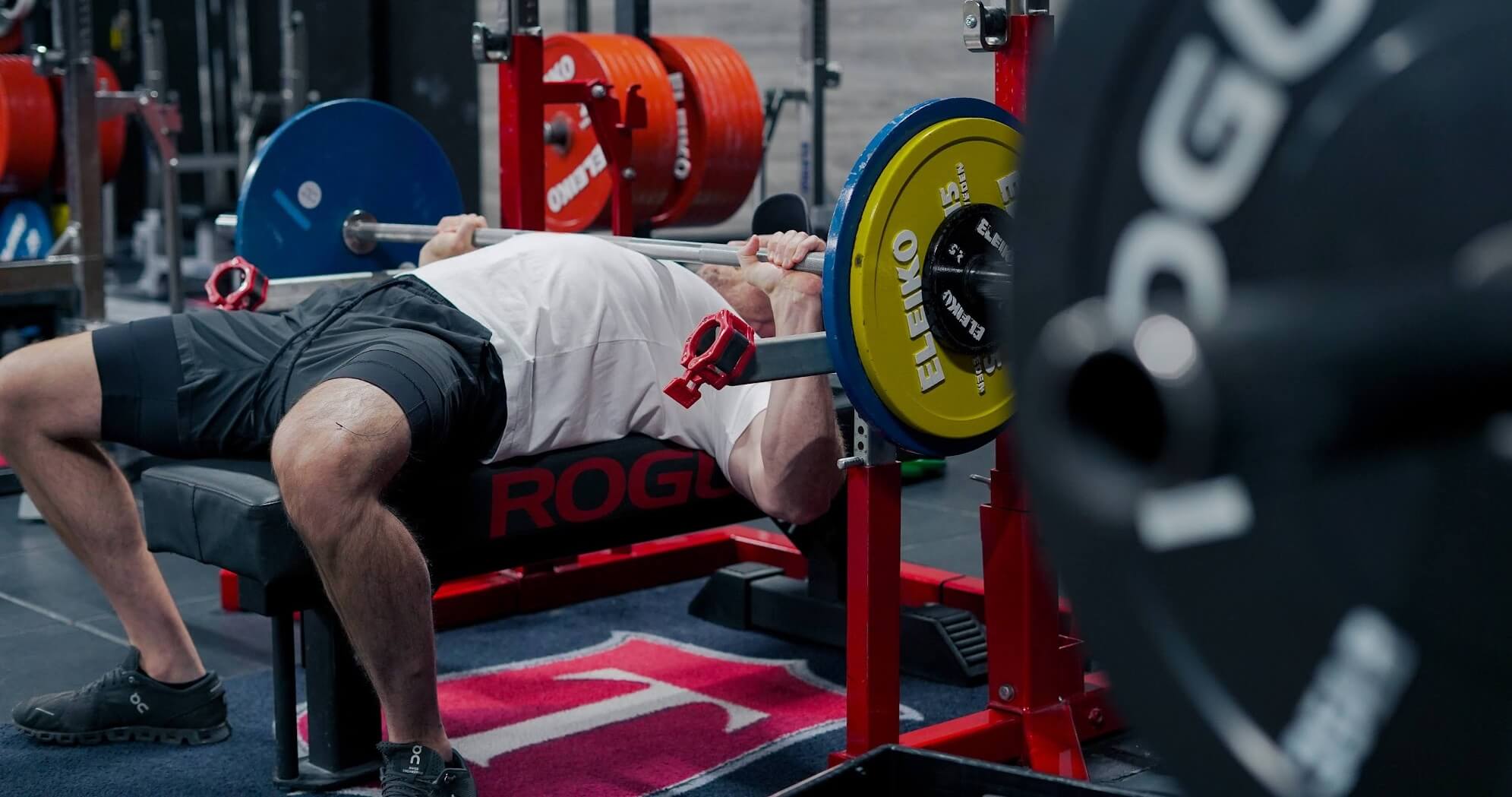
Below, you’ll find beginner, intermediate, and advanced upper chest workouts to help you build upper chest size and strength no matter your experience level.
Upper Chest Workout Routine #1: Beginner
If you’ve been training for a year or less, do this upper chest workout once per week in place of a chest or push day:
- Incline Barbell Bench Press: 3 sets | 4-to-6 reps | 3-to-5 min rest
- Flat Dumbbell Bench Press: 3 sets | 4-to-6 reps | 3-to-5 min rest
- Close-Grip Barbell Bench Press: 2 sets | 6-to-8 reps | 2-to-3 min rest
- Low-to-High Cable Fly: 2 sets | 6-to-8 reps | 2-to-3 min rest
Upper Chest Workout Routine #2: Intermediate
If you’ve been training for 1-to-3 years, increasing your training volume will likely help you build muscle faster. Here’s how you could structure two upper chest–focused sessions per week by adapting a push day and upper body day from Bigger Leaner Stronger:
Workout 1: Push
- Incline Barbell Bench Press: 3 sets | 4-to-6 reps | 3-to-5 min rest
- Flat Dumbbell Bench Press: 3 sets | 4-to-6 reps | 3-to-5 min rest
- Close-Grip Barbell Bench Press: 2 sets | 6-to-8 reps | 2-to-3 min rest
- Low-to-High Cable Fly: 2 sets | 6-to-8 reps | 2-to-3 min rest
Workout 3: Upper Body A
- Incline Dumbbell Bench Press: 3 sets | 4-to-6 reps | 3-to-5 min rest
- Flat Barbell Bench Press: 3 sets | 4-to-6 reps | 3-to-5 min rest
- Dumbbell Side Lateral Raise: 3 sets | 6-to-8 reps | 2-to-3 min rest
- Dumbbell Rear Lateral Raise: 3 sets | 6-to-8 reps | 2-to-3 min rest
Upper Chest Workout Routine #3: Advanced
If you’ve been training for over 3 years and want to push volume to the upper end of the optimal range, here’s how you can structure three weekly workouts, based on the routine in Bigger Leaner Stronger:
Workout 1: Push
- Incline Barbell Bench Press: 3 sets | 4-to-6 reps | 3-to-5 min rest
- Flat Dumbbell Bench Press: 3 sets | 4-to-6 reps | 3-to-5 min rest
- Close-Grip Barbell Bench Press: 2 sets | 6-to-8 reps | 2-to-3 min rest
- Low-to-High Cable Fly: 2 sets | 6-to-8 reps | 2-to-3 min rest
Workout 3: Upper Body A
- Incline Dumbbell Bench Press: 3 sets | 4-to-6 reps | 3-to-5 min rest
- Flat Barbell Bench Press: 3 sets | 4-to-6 reps | 3-to-5 min rest
- Dumbbell Side Lateral Raise: 3 sets | 6-to-8 reps | 2-to-3 min rest
- Dumbbell Rear Lateral Raise: 3 sets | 6-to-8 reps | 2-to-3 min rest
Workout 5: Upper Body B
- Close-Grip Barbell Bench Press: 3-to-4 sets | 4-to-6 reps | 3-to-5 min rest
- Chin-up: 3 sets | 4-to-6 reps | 3-to-5 min rest
- Seated Cable Row: 3 sets | 6-to-8 reps | 2-to-3 min rest
- Barbell Curl: 3 sets | 6-to-8 reps | 2-to-3 min rest
Warming Up for Your Upper Chest Workouts
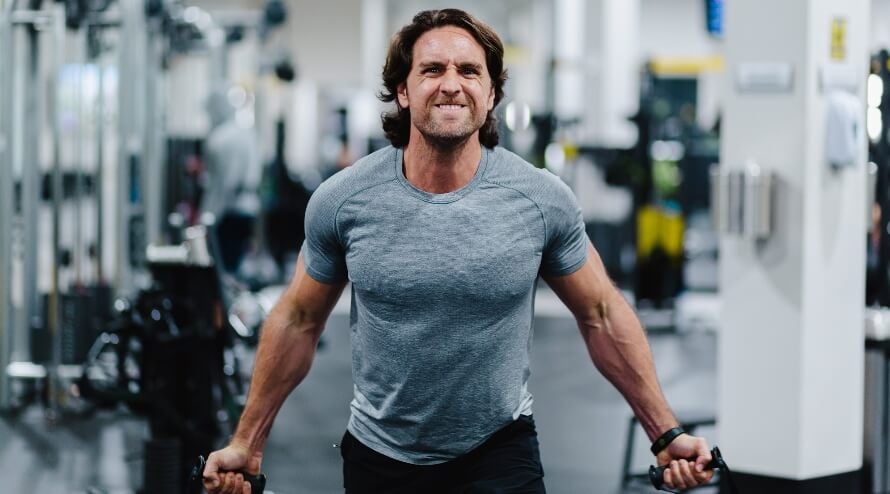
A proper warm-up helps you lift more weight safely and reduces your risk of injury. Research shows the best way to prepare for heavy pressing is to warm up with heavy weights.
Here’s the protocol I recommend:
- Estimate the weight you’ll use for your first hard set of your first exercise.
- Do 6 reps with about 50% of that weight and rest for 1 minute.
- Do 4 reps with about 70% of that weight and rest for 1 minute.
After this, you’re ready to tackle your hard sets for your first exercise and the rest of your upper chest workout.
FAQ #1: Can you do an upper chest workout at home?
Yes, you can do an upper chest workout at home. Do the following workout twice per week on non-consecutive days:
- Decline Push-up: 4 sets | 10-to-30 reps | 3-to-5 min rest
- Close-Grip Push-up: 4 sets | 10-to-30 reps | 3-to-5 min rest
- Pike Push-up: 4 sets | 10-to-30 reps | 3-to-5 min rest
As long as you take each set close to failure, you should see noticeable progress within 3-to-6 months. Just bear in mind that once you can complete each set easily, you’ll need to swap to a more challenging upper chest workout using free-weights to continue gaining size and strength.
FAQ #2: What do you call men’s upper chest?
The upper part of the chest is called the clavicular head of the pectoralis major, or simply the upper pec. While some people think this only applies to men, the anatomy is the same in women. The difference typically comes down to muscle size and development—not structure.
FAQ #3: Do dips work the upper chest?
Yes, dips work the entire chest, including the upper pecs. That said, they’re not as effective for building the upper chest as incline pressing, since they involve less shoulder flexion—one of the primary functions of the clavicular head of the pecs.
READ MORE: An Expert Guide to the Muscles Worked by Dips
Scientific References +
- Rodríguez-Ridao, David, et al. “Effect of Five Bench Inclinations on the Electromyographic Activity of the Pectoralis Major, Anterior Deltoid, and Triceps Brachii during the Bench Press Exercise.” International Journal of Environmental Research and Public Health, vol. 17, no. 19, 8 Oct. 2020, p. 7339, https://doi.org/10.3390/ijerph17197339.
- Trebs AA, Brandenburg JP, Pitney WA. An electromyography analysis of 3 muscles surrounding the shoulder joint during the performance of a chest press exercise at several angles. J strength Cond Res. 2010;24(7):1925-1930. doi:10.1519/JSC.0b013e3181ddfae7
- Lauver, Jakob D., et al. “Influence of Bench Angle on Upper Extremity Muscular Activation during Bench Press Exercise.” European Journal of Sport Science, vol. 16, no. 3, 23 Mar. 2015, pp. 309–316, https://doi.org/10.1080/17461391.2015.1022605.
- “View of the Resistance Training Dose-Response: Meta-Regressions Exploring the Effects of Weekly Volume and Frequency on Muscle Hypertrophy and Strength Gain.” Sportrxiv.org, 2024, sportrxiv.org/index.php/server/preprint/view/460/967.
- “Set Volume for Muscle Size: The Ultimate Evidence Based Bible.” Weightology, weightology.net/the-members-area/evidence-based-guides/set-volume-for-muscle-size-the-ultimate-evidence-based-bible/.
- Stokes, Tanner, et al. “Recent Perspectives Regarding the Role of Dietary Protein for the Promotion of Muscle Hypertrophy with Resistance Exercise Training.” Nutrients, vol. 10, no. 2, 7 Feb. 2018, p. 180, www.mdpi.com/2072-6643/10/2/180/pdf.
- Eckerson, Joan M., et al. “Effect of Creatine Phosphate Supplementation on Anaerobic Working Capacity and Body Weight after Two and Six Days of Loading in Men and Women.” The Journal of Strength and Conditioning Research, vol. 19, no. 4, 2005, p. 756, https://doi.org/10.1519/r-16924.1.
- Bassit, Reinaldo Abunasser, et al. “Effect of Short-Term Creatine Supplementation on Markers of Skeletal Muscle Damage after Strenuous Contractile Activity.” European Journal of Applied Physiology, vol. 108, no. 5, 3 Dec. 2009, pp. 945–955, https://doi.org/10.1007/s00421-009-1305-1.
- Roy, Xavier, et al. “The Effect of 12 Variations of the Bench Press Exercise on the EMG Activity of Three Heads of the Pectoralis Major.” International Journal of Strength and Conditioning, vol. 1, no. 1, 1 June 2021, https://doi.org/10.47206/ijsc.v1i1.39.
- Oranchuk, Dustin J., et al. “Isometric Training and Long-Term Adaptations: Effects of Muscle Length, Intensity, and Intent: A Systematic Review.” Scandinavian Journal of Medicine & Science in Sports, vol. 29, no. 4, 13 Jan. 2019, pp. 484–503, onlinelibrary.wiley.com/doi/full/10.1111/sms.13375, https://doi.org/10.1111/sms.13375.
- Barnett, Chris, et al. “Effects of Variations of the Bench Press Exercise on The… : The Journal of Strength & Conditioning Research.” LWW, 2019, journals.lww.com/nsca-jscr/abstract/1995/11000/effects_of_variations_of_the_bench_press_exercise.3.aspx.
- Saeterbakken, Atle Hole, et al. “The Effects of Bench Press Variations in Competitive Athletes on Muscle Activity and Performance.” Journal of Human Kinetics, vol. 57, no. 1, 22 June 2017, pp. 61–71, https://doi.org/10.1515/hukin-2017-0047.
- Kristiansen, M., et al. “Inter-Subject Variability of Muscle Synergies during Bench Press in Power Lifters and Untrained Individuals.” Scandinavian Journal of Medicine & Science in Sports, vol. 25, no. 1, 24 Dec. 2013, pp. 89–97, https://doi.org/10.1111/sms.12167.
- Liao, Kai-Fang , et al. Effects of Unilateral vs. Bilateral Resistance Training Interventions on Measures of Strength, Jump, Linear and Change of Direction Speed: A Systematic Review and Meta-Analysis. Mar. 2022, www.termedia.pl/Effects-of-unilateral-vs-bilateral-resistance-training-interventions-on-measures-of-strength-jump-linear-and-change-of-direction-speed-a-systematic-review-and-meta-analysis,78,44423,0,1.html, https://doi.org/10.5114/biolsport.2022.107024. Accessed Mar. 2022.
- “(PDF) Effects of Variations of the Bench Press Exercise on the EMG Activity of Five Shoulder Muscles.” ResearchGate, www.researchgate.net/publication/232217991_Effects_of_Variations_of_the_Bench_Press_Exercise_on_the_EMG_Activity_of_Five_Shoulder_Muscles.
- Lehman, Gregory J. “The Influence of Grip Width and Forearm Pronation/Supination on Upper-Body Myoelectric Activity during the Flat Bench Press.” The Journal of Strength and Conditioning Research, vol. 19, no. 3, 2005, p. 587, https://doi.org/10.1519/r-15024.1.
- Ribeiro, Bruno, et al. “The Role of Specific Warm-up during Bench Press and Squat Exercises: A Novel Approach.” International Journal of Environmental Research and Public Health, vol. 17, no. 18, 22 Sept. 2020, p. 6882, https://doi.org/10.3390/ijerph17186882.
- Viveiros, Leonardo, et al. “High-Load and Low-Volume Warm-up Increases Performance in a Resistance Training Session.” Journal of Bodywork and Movement Therapies, vol. 40, 1 Oct. 2024, pp. 1487–1491, https://doi.org/10.1016/j.jbmt.2024.08.004.
